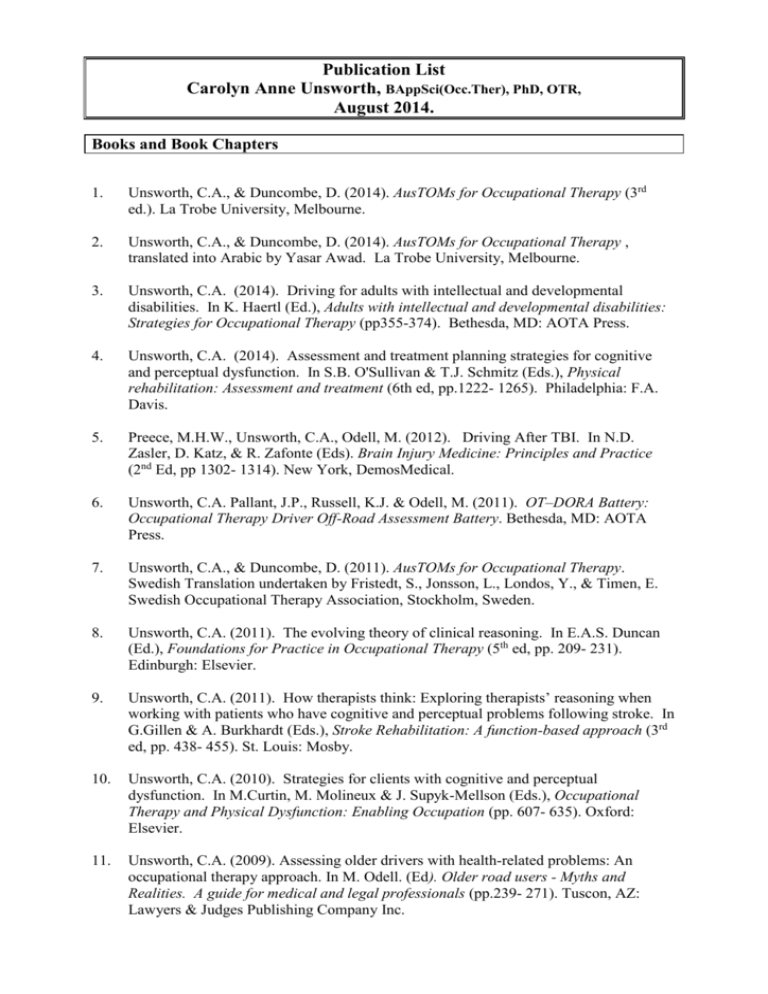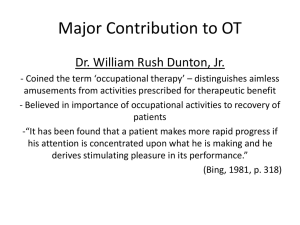
Publication List
Carolyn Anne Unsworth, BAppSci(Occ.Ther), PhD, OTR,
August 2014.
Books and Book Chapters
1.
Unsworth, C.A., & Duncombe, D. (2014). AusTOMs for Occupational Therapy (3rd
ed.). La Trobe University, Melbourne.
2.
Unsworth, C.A., & Duncombe, D. (2014). AusTOMs for Occupational Therapy ,
translated into Arabic by Yasar Awad. La Trobe University, Melbourne.
3.
Unsworth, C.A. (2014). Driving for adults with intellectual and developmental
disabilities. In K. Haertl (Ed.), Adults with intellectual and developmental disabilities:
Strategies for Occupational Therapy (pp355-374). Bethesda, MD: AOTA Press.
4.
Unsworth, C.A. (2014). Assessment and treatment planning strategies for cognitive
and perceptual dysfunction. In S.B. O'Sullivan & T.J. Schmitz (Eds.), Physical
rehabilitation: Assessment and treatment (6th ed, pp.1222- 1265). Philadelphia: F.A.
Davis.
5.
Preece, M.H.W., Unsworth, C.A., Odell, M. (2012). Driving After TBI. In N.D.
Zasler, D. Katz, & R. Zafonte (Eds). Brain Injury Medicine: Principles and Practice
(2nd Ed, pp 1302- 1314). New York, DemosMedical.
6.
Unsworth, C.A. Pallant, J.P., Russell, K.J. & Odell, M. (2011). OT–DORA Battery:
Occupational Therapy Driver Off-Road Assessment Battery. Bethesda, MD: AOTA
Press.
7.
Unsworth, C.A., & Duncombe, D. (2011). AusTOMs for Occupational Therapy.
Swedish Translation undertaken by Fristedt, S., Jonsson, L., Londos, Y., & Timen, E.
Swedish Occupational Therapy Association, Stockholm, Sweden.
8.
Unsworth, C.A. (2011). The evolving theory of clinical reasoning. In E.A.S. Duncan
(Ed.), Foundations for Practice in Occupational Therapy (5th ed, pp. 209- 231).
Edinburgh: Elsevier.
9.
Unsworth, C.A. (2011). How therapists think: Exploring therapists’ reasoning when
working with patients who have cognitive and perceptual problems following stroke. In
G.Gillen & A. Burkhardt (Eds.), Stroke Rehabilitation: A function-based approach (3rd
ed, pp. 438- 455). St. Louis: Mosby.
10.
Unsworth, C.A. (2010). Strategies for clients with cognitive and perceptual
dysfunction. In M.Curtin, M. Molineux & J. Supyk-Mellson (Eds.), Occupational
Therapy and Physical Dysfunction: Enabling Occupation (pp. 607- 635). Oxford:
Elsevier.
11.
Unsworth, C.A. (2009). Assessing older drivers with health-related problems: An
occupational therapy approach. In M. Odell. (Ed). Older road users - Myths and
Realities. A guide for medical and legal professionals (pp.239- 271). Tuscon, AZ:
Lawyers & Judges Publishing Company Inc.
12.
Ballek, D.L. & Unsworth, C.A. (2009). Quantitative research: Surveys and
questionnaires. In A. Perry, M.Morris & S. Cotton (Eds). Handbook for Allied Health
Researchers (pp.40-46). Melbourne: Menzies Foundation.
13.
Unsworth, C.A. (2008). Review of methodologies for researching clinical reasoning.
In B.B.Schell and J.W. Schell (Eds.), Clinical and professional reasoning in
occupational therapy (pp. 371- 400). Philadelphia: Lippincott, Williams & Wilkins.
14.
Schell, B.B., Unsworth, C.A. & Schell, J.W. (2008). Theory and practice: New
directions for research in professional reasoning. In B.B.Schell and J.W. Schell (Eds.),
Clinical and professional reasoning in occupational therapy (pp. 401- 431).
Philadelphia: Lippincott, Williams & Wilkins.
15.
Unsworth, C.A., & Duncombe, D. (2007). AusTOMs for Occupational Therapy (2nd
ed.). La Trobe University, Melbourne.
16.
Unsworth, C.A. (2006). Assessment and treatment planning strategies for cognitive
and perceptual dysfunction. In S.B. O'Sullivan & T.J. Schmitz (Eds.), Physical
rehabilitation: Assessment and treatment (5th ed, pp.1149-1188). Philadelphia: F.A.
Davis.
17.
Unsworth, C.A., & Duncombe, D. (2004). AusTOMs for Occupational Therapy. La
Trobe University, Melbourne.
18.
Unsworth, C.A. (2004). How therapists think: Exploring therapists’ reasoning when
working with patients who have cognitive and perceptual problems following stroke. In
G.Gillen & A. Burkhardt (Eds.), Stroke Rehabilitation: A function-based approach (2nd
ed, pp. 358- 375). St. Louis: Mosby.
19.
Unsworth, C.A. (2004). Descriptive and exploratory data analysis. In V. Minichiello et
al. (Ed.), Research methods for nursing and health sciences 2nd ed, (pp. 516- 542).
Sydney: Pearson, Prentice hall.
20.
Skeat, J., Perry, A., Morris, M., Unsworth, C., Duckett, S., Dodd, K., Taylor, N. (2003).
The use of the ICF framework in an allied health outcome measure: Australian Therapy
Outcome Measures (AusTOMs). In Australian Institute of Health and Welfare, ICF
Australian user guide. Version 1.0. (pp. 77- 81). Canberra: Australian Institute of
Health and Welfare.
21.
Unsworth, C.A. & Warburg, C.L. (2001). Assessment and treatment planning strategies
for cognitive and perceptual dysfunction. In S.B. O'Sullivan & T.J. Schmitz (Eds.),
Physical rehabilitation: Assessment and treatment (4th ed, pp. 961- 999). Philadelphia:
F.A. Davis.
22.
Unsworth, C.A. (1999). Cognitive and perceptual disorders: A clinical reasoning
approach to evaluation and intervention. Philadelphia: F.A. Davis.
23.
Unsworth, C.A. (1999). Introduction to cognitive and perceptual dysfunction:
Theoretical approaches. In C.A. Unsworth, Cognitive and perceptual disorders: A
clinical reasoning approach to evaluation and intervention (pp 1- 41). Philadelphia:
F.A. Davis.
2
24.
Unsworth, C.A. (1999). Clinical reasoning in occupational therapy. In C.A. Unsworth,
Cognitive and perceptual disorders: A clinical reasoning approach to evaluation and
intervention (pp 43- 73). Philadelphia: F.A. Davis.
25.
Unsworth, C.A. (1999). Reflections on the process of therapy in cognitive and
perceptual dysfunction. In C.A. Unsworth, Cognitive and perceptual disorders: A
clinical reasoning approach to evaluation and intervention (pp 75- 124). Philadelphia:
F.A. Davis.
26.
Unsworth, C.A. (1999). Evaluation and intervention with concentration impairment. In
C.A. Unsworth, Cognitive and perceptual disorders: A clinical reasoning approach to
evaluation and intervention (pp 125- 161). Philadelphia: F.A. Davis.
27.
Laver, A., & Unsworth, C.A. (1999). Evaluation and intervention with simple
perceptual impairment (agnosias). In C.A. Unsworth, Cognitive and perceptual
disorders: A clinical reasoning approach to evaluation and intervention (pp 299- 356).
Philadelphia: F.A. Davis.
28.
Corben, L., & Unsworth, C.A. (1999). Evaluation and intervention with unilateral
neglect. In C.A. Unsworth, Cognitive and perceptual disorders: A clinical reasoning
approach to evaluation and intervention (pp 357- 392). Philadelphia: F.A. Davis.
29.
Unsworth, C.A. (1999). Descriptive statistics. In V. Minichiello (Ed.), Handbook of
research methods in health (pp. 479- 498). Sydney: Addison Wesley.
30.
Unsworth, C.A. (1998). Ergonomics for one: Cognitive disabilities. In V. Berg Rice
(Ed.), Ergonomics in health care and rehabilitation (pp. 79- 110). Newton MA:
Butterworth Heinemann.
31.
Vanderwerff, S.M., Unsworth, C.A., Hutchens, J., & Thomas, F. (1989). Feeling great:
A do it yourself guide. Victorian Health Promotion Foundation, Melbourne.
Refereed Journal Articles
32.
Baker, A, Unsworth, C.A. & Lannin, N.A. (2014 accepted). Fitness-to-drive after mild
traumatic brain injury (mTBI). Australian Occupational Therapy Journal.
33.
Bruce, C., & Unsworth, C.A. Tay, R., & Dillon, M (2014 accepted). Reliability of the
Occupational Therapy Risk Perception Test (OT-RiPT) for drivers with disabilities.
Scandinavian Journal of Occupational Therapy.
34.
Unsworth, C.A., Harries, P.A. & Davies (2014 accepted). Using Social Judgment
Theory method to examine how experienced occupational therapy driver assessors use
information to make fitness-to-drive recommendations. British Journal of
Occupational Therapy.
35.
Iacono, T., Bigby, C., Unsworth, C., Douglas, J., Fitzpatrick, P. (2014). Hospital
Experiences of People with Cognitive Disabilities: A Quality and Content Literature
Review. Health Services Research, 14, 505- 512.
36.
Unsworth, C.A., Coulson, M., Swinton, L., Cole, H., & Sarigiannis, M. (2014). How
much client change, as measured on AusTOMs-OT, indicates a minimum clinically
3
important difference (MCID)? Disability and Rehabilitation. DOI
10.3109/09638288.2014.952450
37.
Baker, A, Unsworth, C.A. & Lannin, N.A. (2014 accepted). Fitness-to-drive after mild
traumatic brain injury (mTBI): A systematic review of methods and assessments used in
the acute hospital setting. British Journal of Occupational Therapy.
38.
Timmer, A, Unsworth, C.A. & Taylor, N. (2014). Rehabilitation interventions with
deconditioned older adults following an acute hospital admission: A systematic review.
Clinical Rehabilitation, 28(11), 1078-1086.
39.
Unsworth, C.A. & Baker, A (2014). Driver rehabilitation: A systematic review of the
types and effectiveness of interventions used by occupational therapists to improve onroad fitness-to-drive. Accident Analysis and Prevention, 71, 106-114.
40.
Bruce, C., & Unsworth, C.A., Tay, R. (2014). The efficacy of behavioral interventions
for improving driving outcomes in novice drivers with attention deficit/ hyperactivity
disorders: A systematic review. British Journal of Occupational Therapy, 77 (7), 348357.
41.
Abu-Awad, Y., Unsworth, C.A., Coulson, M., & Sarigiannis, M. (2014). Using the
Australian Therapy Outcome Measures for Occupational Therapy (AusTOMs-OT) to
measure client participation outcomes. British Journal of Occupational Therapy, 77
(2), 44-49.
42.
Harries, P.A. & Unsworth, C.A. (2013). Editorial: Clinical Assessment of fitness-todrive: Positioning occupational therapy for workforce development. British Journal of
Occupational Therapy, 76 (7), 299.
43.
Krishnasamy, K., Unsworth, C., & Howie, L. (2013). Exploring the mobility
preferences and perceived difficulties in using transport and driving with a sample of
healthy and out-patient older adults in Singapore. Australian Occupational Therapy
Journal, 60 (2) 129-137.
44.
Fristedt, S., Elgmark, E. & Unsworth, C.A. (2013). The inter-rater and test-retest
reliability of the Self-care and Transfer scales and intra-rater reliability of all scales of
the Swedish translation of the Australian Therapy Outcome Measures for Occupational
Therapy (AusTOMs-OT-S). Scandinavian Journal of Occupational Therapy, 20, 182189.
45.
Krishnasamy, C., & Unsworth, C.A. (2012). Validity of the Occupational Therapy
Drive Home Maze Test for right and left handed test takers. Accident Analysis and
Prevention, 49, 274- 277.
46.
Chaffey, L., Unsworth, C., & Fossey, E. (2012). The relationship of intuition and
emotional intelligence among occupational therapists in mental health practice.
American Journal of Occupational Therapy, 66 (1), 88- 96.
47.
Unsworth, C.A., Baker, A., Taitz, C., Chan, SP, Pallant, J.F, Russell, K., & Odell, M. &
Coulson, M. (2012). Development of a standardised Occupational Therapy Driver Off
Road Assessment (OT-DORA) battery to assess older and/ or functionally impaired
drivers. Australian Occupational Therapy Journal, 59(1), 23- 36.
4
5th most downloaded article from 2012 with 1,173 downloads.
48.
Unsworth, C.A. (2012). Editorial, Community mobility promotes participation for
people of all ages and ability. Australian Occupational Therapy Journal, 59(1), 1.
49.
Krishnasamy, C., Unsworth, C., & Howie, L. (2011). The patterns of activity, and
transport to activities among older adults in Singapore. Hong Kong Journal of
Occupational Therapy, 21 (2), 80-87.
50.
Unsworth, C.A. (2011). Editorial. Evidence-based practice depends on the routine use
of outcome measures. British Journal of Occupational Therapy, 74(5), 209.
51.
Unsworth, C.A., Pallant, J.F, Russell, K., Odell, M. & Coulson, M. (2011). Inter-rater
reliability of the Road Law and Road Craft test as part of the OT-DORA Batter for offroad Driver assessment. British Journal of Occupational Therapy, 74, 394- 39.
52.
Sheppard, L. & Unsworth, C.A. (2011). Developing skills in everyday activities and
self-determination in adolescents with intellectual and developmental disabilities.
Remedial and Special Education 32 (5), 393-405.
53.
Unsworth, C.A., (2011). Gaining insights to the clinical reasoning that supports an onroad driver assessment. Canadian Journal of Occupational Therapy, 78(2), 97- 102.
54.
Krishnasamy, C., & Unsworth, C.A. (2011). Normative data, preliminary inter rater
reliability and predictive validity of the Drive Home Maze Test. Clinical Rehabilitation,
25, 88- 95.
55.
Unsworth, C. A. (2010). Issues surrounding driving and driver assessment for people
with mental health problems. Occupational Therapy in Mental Health, 15 (2), 41- 44.
56.
Chaffey, L., Unsworth, CA, & Fossey, E. (2010). A grounded theory of intuition
among occupational therapists in mental health practice. British Journal of
Occupational Therapy, 73 (7), 300-308.
57.
Brown, T., & Unsworth, C. (2009). Construct validity of the test of visual-motor
integration: An evaluation using rasch analysis. Hong Kong Journal of Occupational
Therapy, 19(1), 2- 13.
58.
Brown, T., Unsworth, C. & Lyons, C. (2009). An evaluation of the construct validity of
the Developmental Test of Visual-Motor Integration using the Rasch measurement
Model. Australian Occupational Therapy Journal, 56(6), 393- 402.
59.
Brown, T., Unsworth, C. & Lyons, C. (2009). Factor Structure of Four Visual-Motor
Instruments Commonly used to Evaluate School-Aged Children. American Journal of
Occupational Therapy, 63(6), 710- 723.
60.
Unsworth, C.A., Bearup, A., & Rickard, K. (2009). A benchmark comparison of
outcomes for clients with upper limb dysfunction following stroke using the Australian
Therapy Outcome Measures for Occupational Therapy (AusTOMs-OT). American
Journal of Occupational Therapy, 63 (6), 732- 743.
5
61.
Brown, T., Unsworth, C. (2009). Construct validity of the Test of Visual-Motor SkillsRevised (TVMS-R): An evaluation using the Rasch Measurement Model. Scandinavian
Journal of Occupational Therapy, 16 (3), 133-145.
62.
Brown, T., & Unsworth, (2009). Evaluating construct validity of the Slossen visualmotor performance test using the rasch measurement model. Perceptual Motor Skills,
108, 367- 382.
63.
Brown, T., Unsworth, C., Lyons, C. (2009). The internal consistency and concurrent
validity of four instruments used to evaluate the visual motor integration skills of
school-aged children. Journal of Occupational Therapy, Schools, & Early Intervention,
2 (1), 35- 50.
64.
Clemson, L., Bundy, A., Unsworth, C., & Singh, M.F. (2009). Validation of a modified
Assessment of Living Skills and Resources (ALSAR), an IADL measure for older
people. Disability and Rehabilitation, 31 (5), 359-369.
65.
Unsworth, C.A. (2008). Using the Australian Therapy Outcome Measures for
Occupational Therapy (AusTOMs-OT) to measure outcomes for clients following
stroke. Topics in Stroke Rehabilitation, 15 (4), 351- 364.
66.
Unsworth, C.A., Wells, Y., Browning, C., Kendig, H., & Thomas, S.A (2007). To
continue, modify or relinquish driving: Findings from a longitudinal study of healthy
ageing . Gerontology: International Journal of Experimental, Clinical and Behavioral
Gerontology, 53, 423- 431.
67.
Unsworth, C.A.(2007). Development and current status of occupational therapy driver
assessment and rehabilitation in Victoria, Australia. Australian Occupational Therapy
Journal,54, 153- 156.
68.
Unsworth, C.A., (2007). Using social judgment theory to study occupational therapists’
use of information when making licensing recommendations to older and functionally
impaired drivers. American Journal of Occupational Therapy, 61 (5), 493- 502.
69.
Scott, F., Unsworth, C.A., Fricke, J., Taylor, N. (2006). Reliability of the Australian
Therapy Outcome Measures for Occupational Therapy (AusTOMs – OT) Self-care
scale. Australian Occupational Therapy Journal,, 53, 265- 276.
70.
Winkler, D., Unsworth, C.A. & Sloan, S. (2006). Factors that lead to successful
community integration following severe traumatic brain injury. Journal of Head
Trauma Rehabilitation, 21(1), 8-21.
71.
Unsworth, C.A., & Duncombe, D. (2005). A comparison of client outcomes from two
acute care neurological services using self care data from the Australian Therapy
Outcome Measures for Occupational Therapy (AusTOMs - OT). British Journal of
Occupational Therapy, 68(10), 477- 482.
72.
Morris, M., Perry, A., Unsworth, C., Skeat, J., Taylor, N., Dodd, K., Duncombe., D., &
Duckett, S. (2005). Reliability of the Australian Therapy Outcome Measures for
quantifying disability and health International Journal of Therapy and Rehabilitation,
12(8), 340-346.
6
73.
Unsworth, C.A.(2005). Measuring outcomes using the Australian Therapy Outcome
Measures for Occupational Therapy (AusTOMs - OT): Data description and tool
sensitivity. British Journal of Occupational Therapy,68(8), 354- 366.
74.
Winkler, D., Unsworth, C.A. & Sloan, S. (2005). Time-use following a severe traumatic
brain injury. Journal of Occupational Science, 12(2), 69-81.
75.
Mitchell, R.. & Unsworth, C.A. (2005). Clinical reasoning during community health
home visits: Expert and novice differences. British Journal of Occupational Therapy,
68(5), 215-223.
76.
Eyres, L., & Unsworth, C.A. (2005) Occupational therapy in acute hospitals: The
effectiveness of a pilot program to maintain occupational performance in older clients.
Australian Occupational Therapy Journal, 52, 218- 224.
77.
Unsworth, C.A. Lovell, R., Terrington, N., & Thomas, S. (2005). Review of tests
contributing to the occupational therapy off-road driver assessment. Australian
Occupational Therapy Journal, 52, 57- 74.
78.
Unsworth, C.A. (2005). Using a head-mounted video camera to explore current
conceptualizations of clinical reasoning in occupational therapy. American Journal of
Occupational Therapy, 59, 31- 40.
79.
Perry, A., Morris, M., Unsworth, C., Duckett, S., Skeat, J., Dodd, K., Taylor, N. &
Riley, K. (2004). Therapy Outcome Measures for Allied Health Practitioners in
Australia: The AusTOMs. International Journal for Quality in Health Care, 16 (4),
285- 291.
80.
Unsworth, C., Duckett, S., Duncombe, D., Perry, A., Skeat, J., Taylor., N. (2004).
Validity of the AusTOM Scales: A comparison of the AusTOMs and EuroQol-5D.
Health and Quality of Life Outcomes,2, 64-75.
81.
Fricke, J., Collister, L. & Unsworth, C.A. (2004). Commentary – A home-based
occupational therapy environmental modification program for caregivers had a modest
effect on the performance of IADL in people with dementia, while for some caregiver
subgroups, there was improved efficacy and reduced upset. Australian Occupational
Therapy Journal, 51, 166- 169.
82.
Mitchell, R.. & Unsworth, C.A. (2004). Role perceptions and clinical reasoning of
community health occupational therapists undertaking home visits. Australian
Occupational Therapy Journal, 51, 13- 24.
83.
Unsworth, C.A. (2004). Clinical Reasoning: How do worldview, pragmatic reasoning
and client-centredness fit? British Journal of Occupational Therapy, 67, 10- 19.
84.
Stagnitti, K., & Unsworth, C.A. (2004). The test-retest reliability of the child-initiated
pretend play assessment. American Journal of Occupational Therapy, 58, 93- 99.
85.
Unsworth, C. A. & Thomas, S.A. (2003). External validation of a housing
recommendation model for clients following stroke rehabilitation. Disability and
Rehabilitation, 25, 1208- 1218.
7
86.
Unsworth, C.A., & Cunningham, D.T. (2002). Examining the evidence base for
occupational therapy with clients following stroke. British Journal of Occupational
Therapy, 65, 21- 29.
87.
Unsworth, C.A. (2001). The clinical reasoning of novice and expert occupational
therapists. Scandinavian Journal of Occupational Therapy, 8, 163-173.
88.
Unsworth, C.A. (2001). Using a head-mounted video camera to study clinical
reasoning. American Journal of Occupational Therapy, 55, 582- 588.
89.
Fricke J, Unsworth, C.A. (2001). Time use and the importance of instrumental
activities of daily living. Australian Occupational Therapy Journal, 48, 118- 131.
90.
Unsworth, C.A. (2001). Selection for rehabilitation: Acute care discharge patterns of
stroke and orthopeadic patients. International Journal of Rehabilitation Research, 24,
103- 114.
91.
Hilton K, Fricke J, & Unsworth C.A. (2001). A comparison of self-report versus
observation of performance using the Assessment of Living Skills and Resources
(ALSAR) with an older population. British Journal of Occupational Therapy, 64, 135143.
92.
Stagnitti, K., Unsworth, C.A. & Rogers, S. (2000). Development of an assessment to
identify play behaviors that discriminate between the play of typical preschoolers and
preschoolers with pre- academic problems. Canadian Journal of Occupational
Therapy, 67, 291- 303.
93.
Stagnitti, K., & Unsworth, C.A. (2000). The importance of pretend play in child
development: An occupational therapy perspective. British Journal of Occupational
Therapy, 63, 121- 127.
94.
Unsworth, C.A. (2000). Measuring the outcome of occupational therapy: Tools and
resources. Australian Occupational Therapy Journal, 47, 147- 158.
95.
Unsworth, C.A. (1999). Living with epilepsy: Safety during home, leisure and work
activities. Australian Occupational Therapy Journal, 46, 89- 98.
96.
Lindquist, B., & Unsworth, C.A. (1999). Occupational therapy - reflections on the state
of the art. Bulletin of the World Federation of Occupational Therapy, 38, 8 - 13.
97.
Fricke, J., & Unsworth, C.A. (1998). Occupational therapists' conceptions of
instrumental activities of daily living in relation to evaluation and intervention with
older adults. Scandinavian Journal of Occupational Therapy, 5, 180- 191.
98.
Dean, D., & Unsworth, C. A. (1997). Occupational therapists' and stroke clients'
agreement on three outcome measures. Scandinavian Journal of Occupational
Therapy, 4, 6- 13.
99.
Unsworth, C.A., Thomas, S.A. & Greenwood, K.M. (1997). Decision polarization
among rehabilitation team recommendations concerning discharge housing for stroke
patients. International Journal of Rehabilitation Research, 20, 51-68.
8
100. Unsworth, C.A., Osberg, J.S., & Graham, A. (1997). Admitting pediatric trauma
patients to rehabilitation following acute care: Decision making practices in the U.S.A.
and Australia. Journal of Pediatric Rehabilitation, 1, 207- 218.
101. Unsworth, C.A., & Townsend, M.C. (1997). Occupational therapists' skills and attitudes
regarding use of computers and assistive technology. Occupational Therapy
International, 4 (1), 52- 65.
102. Fricke, J., & Unsworth, C. A. (1997). Inter-rater reliability of the original and modified
Barthel Index, and a comparison with the Functional independence Measure.
Australian Occupational Therapy Journal, 44, 22- 29.
103. Osberg, J.S., & Unsworth, C.A. (1997). Trauma-rehabilitation connections: Discharge
and admission decisions for children. Journal of Pediatric Rehabilitation, 1, 131- 146.
104. Yeh, L.S., Unsworth, C.A., & Smith, H.D. (1996). Performance of chopstick use in
healthy Taiwanese adults and clients with rheumatoid arthritis. Abstract. Arthritis and
Rheumatism, 39 (9), 12.
105. Unsworth, C.A. (1996). Clients' perceptions of discharge housing decisions following
stroke rehabilitation. American Journal of Occupational Therapy, 50, 207- 216.
106. Unsworth, C.A. (1996). Team decision making in rehabilitation. American Journal of
Physical Medicine and Rehabilitation, 75, 483- 484.
107. Unsworth, C.A., Thomas, S.A. & Greenwood, K.M. (1995). Rehabilitation team
decisions concerning discharge housing for stroke patients. Archives of Physical
Medicine and Rehabilitation, 76, 331- 340.
108. Unsworth, C.A. (1993). The concept of function. British Journal of Occupational
Therapy, 56, 287- 292.
109. Unsworth, C.A., & Thomas, S.A. (1993). Information use in discharge accommodation
recommendations for stroke patients. Clinical Rehabilitation, 7, 181- 188.
110. Fricke, J., Unsworth, C.A., & Worrell, D. (1993). Reliability of the Functional
Independence Measure (FIM) with Occupational Therapists. Australian Occupational
Therapy Journal, 40, 5- 13.
111. Fricke, J., & Unsworth, C.A. (1992). Viewpoint: The status of activities of daily living:
A Victorian perspective. Australian Occupational Therapy Journal, 39,29-31.
Non-refereed Publications
112. Unsworth, C. A. (2001). Studying Clinical Reasoning. Letter to the Editor. British
Occupational Therapy Journal, 64,316-317.
113. Unsworth, C.A. (1997). Stroke rehabilitation from a therapy perspective. Australian
Association of Gerontology, 1, 10.
114. Unsworth, C. A. (1997). Letter to the Editor. American Journal of Physical Medicine
and Rehabilitation, 76, 348.
9
115. Unsworth, C.A. (1995). The role of occupational therapists in team discharge planning.
Occupational Therapy Practice, 1, 32-33.
116. Unsworth, C.A. (1994). Thesis Abstract. Discharge accommodation recommendations
for stroke patients following rehabilitation: A study of clinician and team decisions.
Australian Occupational Therapy Journal, 41, 143- 144.
117. Fricke, J., & Unsworth, C. A. (1992). Letter to the Editor. Comment on clinical
perspectives. Australian Occupational Therapy Journal, 39,4.
10






